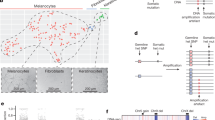Abstract
IT is an obvious empirical fact that the differentiated cells of the adult organism, if they are capable of dividing at all, 'breed true' and preserve for ever in cellular inheritance their specificity of histological type. Even under the regime of tissue culture, in which a cell lineage may well comprise a hundred generations, there is' no reduction of embryological rank, and no degradation of histological specificity that is not a mere matter of 'nurture' and reversible oat will. What is the mechanism of conservative inheritance in the cell lineages generated by mere asexual fission ? An attempt will be made to answer this question by special reference to two cytogenetically distinct but closely related types of cell : those of the 'white' and 'black' epidermal epithelia of guinea pigs' skin. It will be suggested that the inherited difference between them is due to the possession by the black epidermis of a cytoplasmic self-reproducing system concerned with melanogenosis that has some of the properties of what are usually called 'viruses'. Analysis of the type we have undertaken is, indeed, only made possible by the circumstance that black skin is capable of 'infecting' white, and endowing it with its own cellular phenotype ; a process which is in some respects analogous to a cross between sexual organisms, and which has the same methodological significance for the study of cellular heredity as the phenomenon of segregation has for Mendelian genetics.
Similar content being viewed by others
References
Carnot, P., and Deflandre, C., C.R. Soc. Biol. Paris, 48, 178, 430 (1896).
Loeb, L., Arch. EntwMech. Org., 6, 1 (1897).
Loeb, L., "The Biological Basis of Individuality", pp. 14, 141 (Springfield, 1945). Kelley, R. W., and Loeb, L., Anat. Rec., 74, 487 (1939).
The view adopted by Saxton, J. A., Schmeckebier, M. M., and Kelley, R. W., Biol. Bull, 71, 453 (1936); Fessler, A., Brit. J. Dermatol., 53, 201 (1941); but rejected by Lewin, M. L., and Peck, S. M., J. Invest. Dermatol., 4, 483 (1941).
Our operation was based on the description of claw anatomy by le Gros Clark, W. E., Proc. Zool. Soc., 1, 1 (1936).
Fessler, A., Brit. J. Dermatol, 53, 201 (1941).
Cf. Claude, A., Science, 97, 451 (1943).
Lindegren, C. C., Ann. Mo. Bot. Gard., 32, 107 (1945); Proc. Nat. Acad. Sci., 32, 68 (1946).
Spiegelman, S., Ann. Mo. Bot. Gard., 32, 139 (1945).
Darlington, C. D., Nature, 154, 164 (1944).
Haddow, A. M., Nature, 154, 194 (1944).
Sonneborn, T. M., Proc. Nat. Acad. Sci., 29, 329, 338 (1943).
Medawar, P. B., Brit. Med. Bull., 3, 70 (1945).
Cf. Needham, J., "Biochemistry and Morphogenesis", 267 (Cambridge, 1942).
Sale, L., Arch. EntwMech. Org., 37, 248 (1913). Seelig, M. G., Arch. EntwMech. Org., 37, 259 (1913).
Medawar, P. B., J. Anat. Lond. 78, 176 (1944); 79, 157 (1945).
Author information
Authors and Affiliations
Rights and permissions
About this article
Cite this article
BILLINGHAM, R., MEDAWAR, P. THE 'CYTOGENETICS' OF BLACK AND WHITE GUINEA PIG SKIN. Nature 159, 115–117 (1947). https://doi.org/10.1038/159115a0
Issue Date:
DOI: https://doi.org/10.1038/159115a0
- Springer Nature Limited
This article is cited by
-
Part II: Assets and Deficiencies of Available Sources of Radiant Energy for Medical Uses: Deficiencies of Available Sources of Radiant Energy for Medical Uses
Journal of Investigative Dermatology (1959)
-
An Attempt to Induce “Pigment Spread” in Freckled Human Skin11From the Department of Anatomy, St. Mary's Hospital Medical School, London, W.2, England.
Journal of Investigative Dermatology (1959)
-
Genetics and immunology
Heredity (1948)
-
Pigment spread and cell heredity in guinea-pigs' skin
Heredity (1948)
-
Role of Dendritic Cells in the Infective Colour Transformation of Guinea Pig's Skin
Nature (1947)





